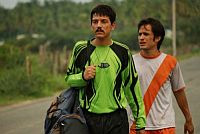
|  |  |  Entertainment | March 2009 Entertainment | March 2009  
Latino Fest in the Fray of Pop Culture's Lucha Libre
 Enrique Gili - Inter Press Service Enrique Gili - Inter Press Service
go to original


| | Diego Luna (left) and Gael Garcia Bernal in "Rudo y Cursi". (San Diego Latino Film Festival) |  |
San Diego, California, Mar 22 (IPS) - The San Diego Latino Film Festival is perhaps the biggest little film festival most people outside of Southern California have never heard of.

Big because the festival showcases the vast array of talent living on both sides of the U.S.-Mexico border, and small because the commercial appeal of Spanish-speaking films in the U.S. market is almost negligible.

Nonetheless, the festival attracts a diverse crowd eager to create their own space in modern cinema. An estimated 20,000-plus people attend the festival over the course of a two-week period from Mar. 12 through Mar. 22.

Now in its 16th season, the festival is the brainchild of Ethan Van Thillo, executive director of the Media Arts Centre San Diego, a city-wide nonprofit organisation dedicated to promoting technical skills and media literacy in underserved communities.

The festival began modestly, showing student films in improvised spaces and later growing into its present format located in a multiplex movie theatre near downtown San Diego. This year, the festival screened 173 entrants, including feature-length films, shorts, and documentaries, from as far afield as Argentina and nearby as Tijuana, Mexico.

Sales are brisk at the box office, attracting a large crowd waiting in eager anticipation to see movies ranging in spectrum from light comedic fare to prison dramas. "We have to offer something for everyone," Van Thillo said.

"We’ve seen a lot of great work come out of film schools in Mexico, Argentina and Spain," he explained, observing the career arc of directors who have presented at the festival in prior years and are now returning to the festival with feature-length projects.

He’s showcased the early films of Alfonso Cuaron (Y Tu Mama Tambien) and Guillermo del Toro (Pan’s Labyrinth), among others. Both Mexican-born filmmakers have matured into movie-making powerhouses working in their native country and abroad.

This year, Carlos Cuaron, Alfonso’s bother and co-writer of "Y Tu Mama Tambien", has returned with "Rudo y Cursi" in the hopes of having similar success.

Standouts include Sundance favourite "Sin Nombre", a border thriller, and "The Garden", an award-winning documentary set in Los Angeles that follows a Mexican-American community’s effort to protect an urban farm from development.

The San Diego Latino film festival, the second largest in the country, has become an essential stopping point for Hispanic filmmakers seeking welcoming audiences.

"I got the film bug early," said film director Javier Chapa, a fifth generation Texan of Mexican-American ancestry, who was accompanied by his multicultural cast and crew to screen the premier of "Pepe & Santos Vs. the United States", a light-hearted comedy set in Brownsville, Texas about the misadventures of day labourers in their efforts to own a house.

Making the movie, Chapa had an epiphany. "I thought, why don’t we celebrate Hispanic culture through comedy?" he said. "Pepe & Santos" combines elements of a Capra-esque fable mixed with the socially conscious "El Norte."

The film played to a predominantly Hispanic crowd grown accustomed to seeing negative portrayals of the immigrant experience. In the question-and-answer session that followed, more than one viewer felt compelled to thank Chapa for making a movie they and "our children could watch."

In 50 years' time, media anthropologists wishing to study the demographic shift currently taking place across the United States might look to Latino film festivals popping up around the United States. They can be found not just in warm-blooded cities such as Miami, Phoenix and Los Angeles, but urban outposts like Chicago and San Francisco.

As Hispanics emerge from their ethnic enclaves in search of greater job and economic opportunities, they are bringing their culture with them. In doing so, they are shaping the lucha libre that is U.S. pop culture.

At the film festival, the two cultures intertwine. Film geeks mingle with middle-class Hispanic families. Spanish freely mixes with English, often in tandem. The films are as diverse as the populations they portray.

According to the U.S. Census, Hispanics are 15 percent of the U.S. population. By 2050, they will make up one-third. In border states, Hispanics already belong to a minority- majority population that includes Asians and African-Americans.

Van Thillo calculates that 80 percent of the audience is Hispanic, but increasingly, non-Latinos are discovering Spanish-language films. "There’s been an explosion of interest in all things Latino," he said.

Spanish-language films are often lost in translation in U.S. markets, paling in comparison in terms of box office receipts - no matter how favourably reviewed or well-attended.

However, last year, "La Misma Luna" broke box office records for a Spanish-language film, earning 2.5 million dollars on its opening weekend - numbers that can make a studio executive think twice when searching for profitable film projects.

In general, success still remains elusive for Latino filmmakers working in either language. "The potential of Latino cinema is to be international," Van Thillo said. |

 |
|  |



